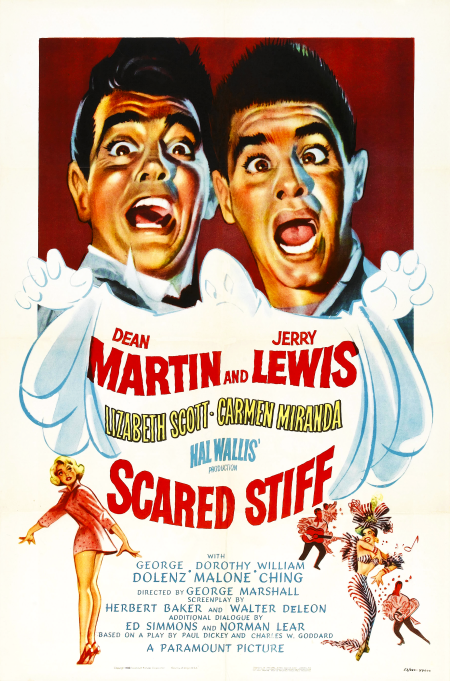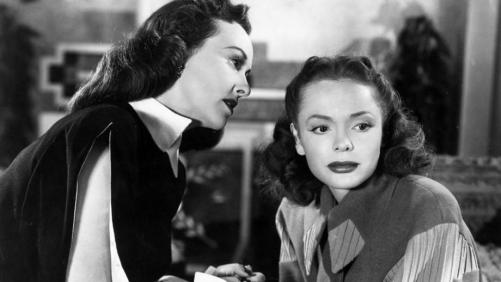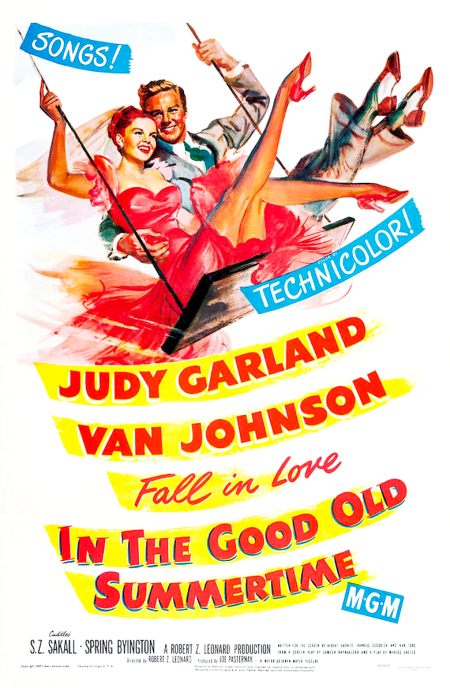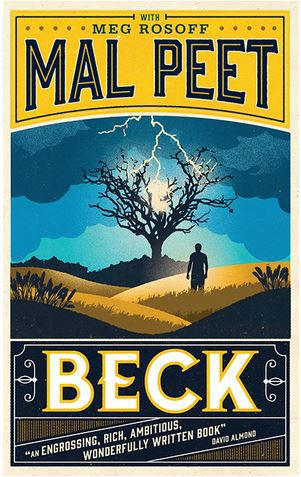Hello again, everyone! I may be a little late into the new month in bringing this write-up to the table, but I’m really excited to follow in the footsteps on some other great classic film blogs and begin my own list of the five best and worst films that I’ve watched each month. Since I’m such an avid film viewer, I do have to put some restrictions on my list, though, so all of the films that I will be offering mini reviews for here will fit the following criteria:
Without further ado, here are my best and worst picks for the month of June!
The Best of June 5. Scared Stiff (1953)
Have you ever had a craving for a particular actor’s films like you would have a craving for ice cream or pizza? Well, I’ll be the first to admit that this happens to me all the time, and early in June I had a craving for Jerry Lewis’ films, despite having only seen a few before. Hence, I got to broaden my horizons a bit, and Scared Stiff (1953) was just one of three new Jerry Lewis films that I watched, the other two being Living it Up (1954) and The Nutty Professor (1963). There were different aspects of all three that I thoroughly enjoyed and I think all three deserve spots on this list, but to be fair to the other contenders I chose to only include one film from my Lewis binge. I’ll be discussing The Nutty Professor (1963) in September as part of the Movie Scientist Blogathon, so it was almost a neck-and-neck tie between the two Martin and Lewis films, but Scared Stiff (1953) won out due to the similarities between the film and The Stooge (1952), a personal favorite of mine. The differences between the two films appealed to me too, of course, like the appearance of one of my favorite underrated actresses, Lizabeth Scott. In the film, singer Larry Todd (Dean Martin) and busboy Myron Mertz (Jerry Lewis) find themselves running away from a group of gangsters after their hides, not too differently than Curtis and Lemmon did in the iconic Some Like it Hot (1959). Instead of dressing up in drag and fleeing to Florida, Larry and Myron find themselves in a haunted mansion in the Carribbean owned by a mysterious heiress (Lizabeth Scott). Seeing Martin and Lewis at their best battling it out with ghosts, trap doors, gangsters, and skeletons (who look an awful lot like Bob Hope and Bing Crosby) was an utter delight, and if you’re looking for some adorable and spooky antics from one of cinema’s best comedy duos, look no further than Scared Stiff (1953)!
4. The Lost Weekend (1945)
This is quite possibly the film on this list that I’ve been wanting to see for the longest time. For years I’ve heard about Billy Wilder’s masterpiece melodrama that won the Academy Award for Best Picture in 1945, but I kept putting off actually sitting down to watch it until I finally caught the film as part of The Essentials on TCM. Of course Wilder didn’t disappoint, and this film brings out many raw emotions in both the characters and the audience. For anyone who struggles with alcoholism or is close to someone who is familiar with the struggle, this film brings out even deeper feelings for antihero Don Birnam (Ray Milland), a desperate man who makes multiple attempts throughout the picture to stay on the wagon of sobriety. Milland’s portrayal of Birnam is absolutely dynamite as he allows the audience to feel sympathy for the character while also maintaining realism as he commits legitimate crimes and hopelessly does whatever it takes in order to get to the next bottle of liquor. It’s incredible how many times I secretly wished that Don would sober up (just as most of the supporting cast did) no matter how deplorable he became and no matter how much his cause appeared to be a lost one. I attribute that faith for the protagonist not only to the performance that earned Milland his first and only Oscar, but also to the ingenious writing and directing by Billy Wilder, one of the best multifaceted filmmakers who ever approached a camera. If you haven’t seen this intense and masterful classic, add it to your watchlist as soon as possible and prepare for some anxiety as you follow Don Birnam through his four-day drinking binge.
3. Her Sister’s Secret (1946)
I just love it when I unexpectedly find a quality B picture, don’t you? That was certainly the case with Her Sister’s Secret (1946), made by notorious “poverty row” studio Producers Releasing Corporation in 1946. I found the film while browsing through Watch TCM earlier in June, and ironically enough it stood out to me because of how absurd the plot was. I mean really, when reading the snippet,”When her soldier lover disappears, a young woman gives up their child to her sister, only to have the man return intent on building a family.”, wouldn’t you regard the storyline as soap opera fodder and move on with your day? That’s almost what I did, but something about it actually drew me in, and after finding nothing better to watch that afternoon I decided to give it a try. I’m certainly glad that I did, because the acting and dialogue in this picture is stellar considering the meager budget and concept, and Her Sister’s Secret (1946) progresses and eventually concludes in a way that is both realistic and makes perfect sense to the audience. Obviously the standout performance here is that of Nancy Coleman as Toni Dubois, the young woman who gives up her child out of the fear and shame that came along with being a single mother at the time. Seeing her immediately regret the decision and seeing her efforts to reunite with her son in the years after his birth is heartbreaking, and Coleman’s portrayal made me feel so much empathy for her character. I’m not entirely certain just how accessible the film is as I stumbled upon it by chance, but if you ever come across this romantic drama yourself, don’t be afraid to give it a second look.
2. He Ran All the Way (1951)
Over the course of the past year or two, noir has slowly but surely become one of my favorite genres in classic film. Recently this has been due to Noir Alley, hosted by the always informative and charming Eddie Muller on TCM. However, my relationship with Noir Alley hasn’t always been a pleasant one, mostly due to its annoying 10am timeslot which (as someone who works nights) falls right in the middle of my sleeping schedule. Since I first began watching the program in April I’ve managed to soldier through most of the films, but when a noir that I wake up just to watch is subpar or just so-so (He Walked by Night (1948) comes to mind), it really gets my goat. Noir Alley’s film for the third week of June put my faith back in the show entirely, and I’m elated to report that I’ve tuned in every week since. Yes, that’s how great it was! The film follows Nick Robey (John Garfield), a small-time crook who attempts to hold up a payroll with his pal Al Molin (played by Norman Lloyd, one of the oldest living classic film stars who’s still making movies at 102!). What was meant to be a quick and easy robbery turns into a farce when Al is killed and a statewide manhunt is issued for Nick, who managed to make a sizeable profit from the heist. While on the run, Nick finds himself at a public swimming pool and meets Peg (Shelley Winters), and he takes a liking to her before deciding to terrorize her and her family by keeping them in their apartment at gunpoint and forcing them to keep him there until he can make a clean getaway with the dough. He Ran All the Way (1951) is an excellent suspense from start to finish, and John Garfield is in his element as a criminal you hate to love, proving to all of us that he was a talent who was taken from us much too soon. Shelley Winters gives a memorable performance as well, and I was so thrilled to see her in a likeable role for once that attempted to play up her beauty. Finally she makes decisions that I can get behind, and a great deal of what made me so impressed with the film was the fact that there was a leading lady in a noir who made every single choice that I like to think I would have given the situation. I don’t think I overstate my case when I say that this is one of the best noirs that I’ve ever seen, and if you’re looking for a thriller that will keep your eyes glued to the screen, believe me when I say that this is it!
1. Hitler’s Madman (1943)
Here we have another dramatic B picture that absolutely stole my heart in June! Hitler’s Madman (1943) drew me in as soon as I saw the cast. First we have Alan Curtis, who really stood out to me in Phantom Lady (1944) despite not having much screen time, but the name that made me immediately turn on the film was that of Patricia Morison. As I mentioned above about the great Norman Lloyd, Patricia is another one of the oldest living classic film stars, who is luckily also still gracing us with her presence at 102! She had a varied and interesting film and stage career, most notably originating the role of Lilli Vanessi in Kiss Me Kate onstage in 1948 (she would later be replaced by Kathryn Grayson for the 1953 film), as well as appearing in the last of Basil Rathbone’s Sherlock Holmes films, Dressed to Kill (1946). I knew most of that information beforehand and had seen her exquisite beauty in photographs, but I had yet to see a film of hers and saw Hitler’s Madman (1943) as a chance to catch her in one of her starring roles. I didn’t expect much from the picture, but boy was I blown away! Like Her Sister’s Secret (1946), Hitler’s Madman (1943) was also made by Producers Releasing Corporation, but MGM saw such potential in the film that they purchased it for their own release, which many film scholars believe is the first time something like that had been done. It takes place in the idyllic Czechoslovakian village of Lidice, which is steadily being taken over by the Nazis. Karel Vavra (Curtis), a soldier serving for the Allies, parachutes into the town that he used to call home and rallies the villagers together in hopes that they will form an uprising and throw the Nazis out. At first the townspeople are too afraid to stand up to their oppressors, but when the demented Reinhardt Heydrich (John Carradine), one of Hitler’s right hand men, begins to throw innocent citizens in jail for fictitious crimes and round up underage girls to be sent to the front lines for German soldiers to use, some of the braver townsfolk plot to get rid of Heydrich once and for all. I was stunned to see so many sensitive subjects brought to light onscreen, and never have I seen a movie that puts the Nazis in as despicable of a light as this one. It’s important to note that this film was made while World War II was still being fought, so I can’t imagine the bravery that was involved in translating these horrific events to the screen. Even more impactful were the acting skills displayed by every actor involved in the production, and the film is heartwrenching to watch as a result. This was the first time in a long time that a film has outright made me bawl while watching it, and I’m sure that it will happen to you too, especially after learning as I did that the events in this film were based on fact. If you want to watch a dark and gripping movie that stands out among the rest of the films made about the Second World War, I would wholeheartedly recommend this one, and be sure to keep an eye out for a very young and alluring Ava Gardner as an extra in some scenes!
The Worst of June 5. Just A Gigolo (1931)
I think a trend that you’ll find often on my blog is that I tend to watch films mostly for the actors who appear in them. That was the case with Just A Gigolo (1931), the first film screened on TCM as part of their Gays in Hollywood theme in June. The film features William Haines, a prolific actor of the 1920s and 1930s whose career was ultimately cut short due to his refusal to leave his partner, interior designer Jimmie Shields. Haines stars in the film as Lord Robert Brummell, a notorious playboy and Casanova who spends most of his time fooling around with married women while dodging their jealous husbands. His uncle Lord George Hampton (C. Aubrey Smith) does everything he can to lead his nephew on a path of righteousness, even setting up an important job interview that Lord Brummell proceeds to blow off and finding him a suitable wife in his close friend’s lovely daughter, Roxanne Hartley (Irene Purcell). Robert is not convinced that Roxy is wife material, however, and makes a wager with his uncle that he can romance Roxy as a gigolo, make her fall in love with him, and expose her as just a common floozy. I’ll be honest when I say that I didn’t hate this film. I didn’t even dislike this film really, but I did find it very forgettable and quite typical as a romantic comedy. What’s more, I agree with the TCM hosts who discussed the film when they say that William Haines wasn’t exactly convincing as a philanderer, and subtle changes were even made to the script that hinted that he batted for the other team. The leading lady, Irene Purcell, stood out to me in a fiery performance, and I must say that I admired her character Roxy as she saw through Lord Brummell’s plans. C. Aubrey Smith was memorable as well in the role of Lord Hampton, and quite frankly had onscreen charisma that rivaled the leading man. All in all, Just A Gigolo (1931) was a disappointing introduction to what promised to be an interesting theme on TCM, and faded into the background in comparison to some other landmark performances by gay actors in Hollywood.
4. Journey Into Fear (1942)
As I mentioned above, I lost some interest in Noir Alley on TCM for a short time this year, and I think it’s easy for me to say that this picture was one of the reasons why. Granted, I wasn’t able to watch Journey Into Fear (1942) when it aired on the channel during the last week of May, but I did catch it while it was still on Watch TCM in early June. Luckily host Eddie Muller’s intro to the movie was still intact and I got to hear about how illustrious filmmaker Orson Welles abandoned the project while it was still in production, and that Welles despised the ending that RKO Pictures filmed without his knowledge so much that he returned to film a new and better ending. I never did learn what the original ending was supposed to be, but I did watch Journey Into Fear (1942) completed as Orson Welles intended. Joseph Cotten plays Howard Graham, a munitions expert who visits Turkey with his wife only to find out that the Nazis are attempting to bump him off and make sure that he doesn’t return to the States. Fortunately for Graham, the Turkish government is sympathetic to his plight, but not at all sympathetic to his marriage as government officials whisk his wife away while hurriedly ushering Graham on a tramp steamer across the Black Sea to Batumi. At first it appears that the Turks’ half-baked plan worked, but soon the munitions expert finds out that armed and dangerous Nazi agents have followed him onboard, and our protagonist must find a way to safety without leaving the ship and without a gun to his name. I suppose Journey Into Fear (1942) qualifies as another film that I didn’t hate, but at times it was very difficult to follow. This is mostly due to the fact that the film commits the faux pas that I’ve found is commonplace in many noirs: there are simply too many characters to keep track of. While I gave the film my undivided attention, I constantly heard names and saw faces that seemed to pop up out of nowhere, and while a diverse cast is always a good thing, an audience should at least get an idea of which characters are most important to the story. Even worse, some of the best stars in the film got little to no screentime, like Orson Welles as Colonel Haki, the Turkish representative who attempts to give Graham safe passage, and Ruth Warrick as Graham’s devoted but confused wife. In general the picture appeared to me to have no heart in it, and seemed like just another excuse for Orson Welles to reunite his Mercury Theater players without actually putting in the necessary effort to make a quality film.
3. Ride the Wild Surf (1964)
As you might imagine, Ride the Wild Surf (1964) qualifies as your typical surfer film, though unfortunately in this case it qualifies to a fault. The picture tells the story of young friends Jody (Fabian), Colton (Peter Brown), and Steamer (Tab Hunter), who arrive in Hawaii with hopes to get lucky both in love and on the arduous waves of Waimea Bay. The plot is so unoriginal that I can’t understand how it got off the ground, but the personalities of some of the characters take the movie from being run-of-the-mill to being just plain awful. Jody is the main culprit; throughout the film he is the epitome of the angsty teenager and somehow manages to get by as a beach bum with no schooling or career path. While Colton and Steamer consider Hawaii a vacation that they’ve studied and worked hard for, Jody just considers Waimea Bay to be just another opportunity to show off his skills on a surfboard, and (spoiler!) of course he wins the big surfing contest, teaching all the kids of the 1960s that if you’re the one in your circle of friends who sheds your responsibilities, you too can get everything you desire in life, including the lovely Shelley Fabares who plays Jody’s love interest, Brie Matthews. In general, Fabian steals far too much screen time in the role, and if his character was written out I’m sure I would have enjoyed this film much more overall. Though it’s not nearly as important, another aspect of Ride the Wild Surf (1964) that annoyed me to no end was the fact that nearly every star who appeared in the movie dyed their hair for it. Shelley Fabares, who is best known today as one of Elvis Presley’s most frequent leading ladies and as a brunette, lightened her hair for the film to contrast her leading man Fabian. Tab Hunter darkened his signature blonde locks to a brunette hue to match his stunt double for the surf scenes, while Peter Brown lightened his hair so that all of the leading men didn’t have dark hair. Barbara Eden, who became an iconic blonde after starring on I Dream of Jeannie (1965-1970), dyed her hair red for the film in order to contrast Peter, making Fabian and Susan Hart (Tab Hunter’s raven-haired love interest) the only actors in the film who didn’t ditch the hair color for which they were most famous. It’s a real shame that I didn’t like this picture more than I did, but Fabian and all of the hair switcheroos proved to be too much for me. If you’re looking to catch some waves this summer and this movie, I wouldn’t necessarily insist that you skip Ride the Wild Surf (1964) but I would recommend that you pay more mind to Shelley Fabares and Barbara Eden, two great actresses of their day who give far better performances in this film than the men do. Also be sure to catch Robert Mitchum’s son James, who is the spitting image of his legendary father in a smaller role as Eskimo!
2. The King’s Thief (1955)
The King’s Thief (1955) is a colorful costume adventure film about Michael McDermott (Edmund Purdom), a highwayman who stumbles upon a notebook belonging to Duke James of Brampton (David Niven), the right hand man of King Charles II (George Sanders). The notebook uncovers a devious plot on the part of the duke, as it lists the names of nobles whom James has falsely accused of treason in order to steal their property and holdings for himself after their execution. The notebook also reveals the nobility that the duke still intends to slander, and Michael hopes to do the right thing for once and reveal the plan to the king himself, especially after meeting and falling in love with Lady Mary (Ann Blyth), a noblewoman whose father was among the wealthy subjects that James already led to the gallows. Michael and Lady Mary attempt to blackmail James at first, which lands the highwayman in prison, but will he escape and deliver the notebook to the king, or will he have to resort to more drastic measures to get his majesty’s attention and reveal the truth? My qualms about the film are few but important nonetheless, my main issue with it being that it absolutely bored me to tears! The swordfights, gambling, romance, and jailbreaks seemed like they were enough to carry the film, but throughout I found myself hardly able to keep my eyes open in the middle of the afternoon. Even the costumes in this costume drama could be considered a hit or miss, with some of Ann Blyth’s dresses being quite lovely and some of the male ensembles being gaudy and unnecessary. For me The King’s Thief (1955) raises a lot of unanswered questions, like “Why did they think Edmund Purdom would look good with a mustache?”, “Why didn’t they cast Basil Rathbone as Duke James instead of David Niven?”, and “Why was George Sanders only in the movie for five minutes?”. A question that does receive an answer, however, is “Should anyone watch this movie?”. If you’re wondering, the answer is no.
1. In the Good Old Summertime (1949)
Earlier in June, I volunteered to write a review about In the Good Old Summertime (1949) for Judy Garland’s birthday. I chose the film myself because it was one of the only classics in Judy’s filmography that I had yet to see, and I was even more excited to write about it because I found out that it was a musical remake of one of my favorite films (and possibly my favorite Christmas film), The Shop Around the Corner (1940), the film which also inspired the iconic Tom Hanks and Meg Ryan vehicle You’ve Got Mail (1998). Quite a few aspects of the original are changed for In the Good Old Summertime (1949); for instance, the setting is a turn-of-the-century music store in America owned by the lovable S.Z. “Cuddles” Sakall instead of a department store in Hungary owned by the even more lovable (in my personal opinion) Frank Morgan. There are many other differences in this film, but the general premise is the same: two coworkers who utterly despise each other, Veronica Fisher (Judy Garland) and Andrew Larkin (Van Johnson), are in the dark about the fact that they’re actually falling in love as each other’s anonymous pen pals. This film has earned the number one spot on my list of the most disliked films of June partially because it butchered such a wonderful and underrated original, but also because of the off-the-charts level of disappointment that I felt after finding that out. I was so disappointed in it, in fact, that I couldn’t even bring myself to write about it on Judy’s birthday, as I simply couldn’t say anything mean about a film that she starred in on a day that we all were celebrating her. In the Good Old Summertime (1949) had all of the ingredients of a film that I might enjoy: stars Judy Garland and Van Johnson, who are not my all-time favorites but I’ve certainly admired them both and appreciated their films, beautiful and colorful costumes, and of course the concept of turning a fine plot into a musical. There are movies that pull off such a feat without a hitch like High Society (1956), but this one blatantly rips off all of the clever dialogue from The Shop Around the Corner (1940) and doesn’t make it sound even half as clever or unique. Most of the changes made for the remake are unwelcome ones except for the addition of the legendary Buster Keaton as the shop owner’s cousin, but even he is criminally underutilized. In conclusion, if any of my readers approached me and told me that they were interested in taking a look at In the Good Old Summertime (1949), or anyone at all for that matter, I would probably feel inclined to grab them by the collar and vehemently direct them to the nearest showing of The Shop Around the Corner (1940), and that’s all there is to it.
Advertisements Share this:




